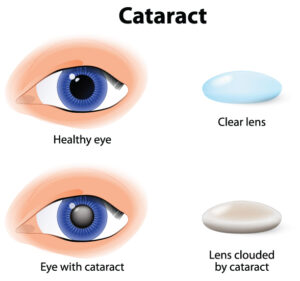Cataracts Symptoms and Treatments
What Causes Cataracts
Most cataracts are due to age-related changes in the lens of the eye that cause it to become cloudy or opaque. However, other factors can contribute to cataract development, including:
- Diabetes Mellitus: People with diabetes are at higher risk for cataracts.
- Drug Interaction: Certain medications are associated with cataract development. These include:
- Corticosteroids
- Chlorpromazine and other phenothiazine-related medications
- Ultraviolet Radiation: Studies show an increased chance of cataract formation with unprotected exposure to ultraviolet (UV) radiation.
- Smoking: There is possibly an association between smoking and increased lens cloudiness.
- Alcohol Consumption: Several studies show increased cataract formation in patients with higher alcohol consumption compared with people who have lower or no alcohol consumption.
- Nutritional Deficiency: Although the results are inconclusive, studies suggest an association between cataract formation and low levels of antioxidants (Such as vitamin C, vitamin E and carotenoids). Further studies may show that antioxidants can help decrease cataract development.
Cataracts generally form very slowly.
Signs and symptoms of a developing cataract may include:- Blurred or hazy vision
- Reduced intensity of colors
- Increased sensitivity to glare from lights, particularly when driving at night
- Increased difficulty seeing at night
- Change in the eye’s refractive error

Cataracts Treatments Available at Perrysburg Eye Center
Eyeglasses and Eyeglass Filters
Anti-glare filters and altered prescriptions can both help to reduce the issues of smaller cataracts and provide temporary vision improvement. Cataracts patients are also encouraged to do things such as reading and computer uses in rooms with plenty of light, to help improve vision by increasing the amount of light getting through the lens.
Surgical Cataracts Correction
When a cataract has progressed to impacting the ability to do everyday tasks, Surgery becomes the best option for removing the obstruction and restoring vision. Cataract surgery involves removing the clouded lens and replacing it with an artificial one. Most artificial lenses today require no maintenance and can significantly improve eyesight.
Two approaches to cataract surgery are generally used:
- Small-incision cataract surgery involves making an incision in the side of the cornea (the clear outer covering of the eye) and inserting a tiny probe into the eye. The probe emits ultrasound waves that soften and break up the lens so it can be suctioned out. This process is called phacoemulsification.
- Extracapsular surgery requires a somewhat larger incision in the cornea so that the lens core can be removed in one piece. The natural lens is replaced by a clear plastic lens called an intraocular lens (IOL). When implanting an IOL is not possible because of other eye problems, contact lenses and, in some cases, eyeglasses may be an option for vision correction.
Get the Help Your Eyes Need Today
We encourage you to contact the Perrysburg Eye center to schedule an appointment with one of our optometrists today by calling us at (419) 874-3125.
